The Blue Moon is Super near Shiny Saturn, Medusa Blinks, Venus Gleams at Sunrise, and Info on Seasons!
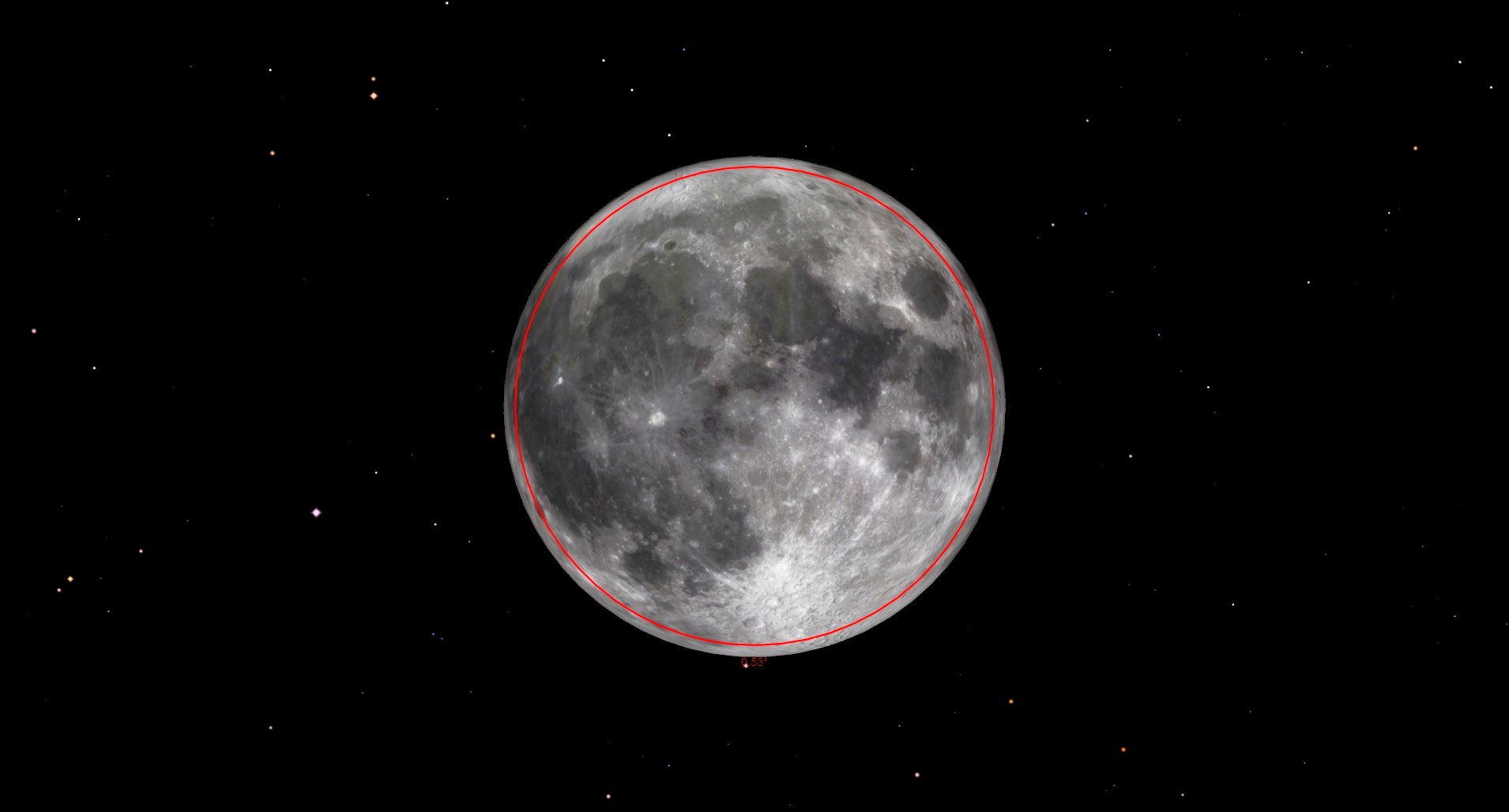
The red ring on this simulated picture shows the size of an average full moon. The full moon on August 30 will be a lunar perigee syzygy, or supermoon – the largest for 2023. (Starry Night Pro 8)
Hello, Late-Summer Stargazers!
Here are your Astronomy Skylights for the week of August 27th, 2023 by Chris Vaughan. Feel free to pass this along to your friends and send me your comments, questions, and suggested topics. I repost these emails with photos at http://astrogeo.ca/skylights/ where the old editions are archived. You can also follow me on Twitter as @astrogeoguy! Unless otherwise noted, all times are expressed in Eastern Time. To subscribe to these emails please click this MailChimp link.
If you’d like me to bring my Digital Starlab portable inflatable planetarium to your school or other daytime or evening event, or deliver a session online, contact me through AstroGeo.ca, and we’ll tour the Universe, or the Earth’s interior, together! My terrific book with John A. Read entitled 110 Things to See With a Telescope is a guide to viewing the deep sky objects in the Messier List – for both beginners and seasoned astronomers. DM me to order a signed copy!
Summer comes to a close – or does it? The bright moon dominates night skies worldwide as it waxes through a full blue supermoon. Mysterious Algol dips in brightness again, bright Jupiter and peak Saturn shine overnight, and Venus gleams as the Morning Star. Read on for your Skylights!
Is Summer Over Yet?
Astronomers define the timing of the four seasons of the year by using the position of the sun along the ecliptic. That’s the imaginary circle around the sky that traces the sun’s motion across the distant background stars due to Earth’s orbital motion around the sun, i.e., our orbital plane. We experience seasons because the Earth’s axis of rotation is tipped, off-setting Earth’s equator and therefore the circle of the celestial equator in the sky above it by 23.5 degrees from the ecliptic. Think of them as crossed hula-hoops with the Earth in the centre.

The sun slides eastward along the ecliptic by about one degree per day. Northern Hemisphere autumn commences on or about September 21 each year, at the moment when the centre of the sun reaches the point on the ecliptic where it intersects the celestial equator. The sun enters the southern celestial hemisphere, kicking off northern fall.
Around March 21, the sun crosses back into the northern celestial hemisphere, bringing spring to the northern hemisphere. Those two equinox days feature about equal amounts of daylight and night. The summer and winter solstices occur in June and December, between the equinoxes, and mark the start of northern summer and winter, respectively. The sun reaches its highest noonday altitude on the summer solstice and its lowest noonday altitude on the winter solstice.
Since the Earth’s orbit is elliptical, Kepler’s Second Law of Planetary Motion dictates that its speed around the sun varies throughout the year. It is moving fastest while it’s closest to the sun at perihelion around January 4, and slowest at aphelion around July 6. The law makes the sun move faster and slower along the ecliptic, shortening the season hosting perihelion and lengthening the one hosting aphelion. In the Northern Hemisphere, summer lasts for 93.65 days and winter (thankfully) lasts for only 88.99 days. For those “down under”, winter is longest and summer is shortest!
Obviously, the weather doesn’t suddenly switch when an astronomical season commences. The ground, water, and atmosphere all take a while to catch up to the sun’s change of intensity and day length. Instead, meteorologists have defined four three-month-long meteorological seasons based upon the annual temperature cycle. Under that definition, fall begins this week, in September 1, winter on December 1, and so on. So, goodbye to summer and welcome to autumn!
A Blue Super-est Moon
Night skies worldwide will be flooded with moonlight this week while our natural night-light waxes through its full moon phase, so our summer Milky Way viewing will have to be put on hold until after the first week of September.
Tonight (Sunday) the bright waxing gibbous moon will shine among the stars of Sagittarius (the Archer), but they’ll be difficult to see against its glare. An interesting offshoot of Earth’s axial tilt is to vary the height of the ecliptic in the sky. The late-summer noonday sun shines high in the sky because the ecliptic is higher than the celestial equator. Twelve hours later, the opposite half of the ecliptic crosses the sky well below the celestial equator’s hula hoop. That holds the moon and planets lower in the night-time sky. Moreover, the moon’s orbit is tilted by about 5 degrees from the ecliptic, causing it to rise and fall as it travels around Earth each month, like horses on a carousel. Recently the moon has been positioned close to its maximum distance below the ecliptic while approaching full. So you’ll notice that the moon doesn’t climb very high at all this week.
The brightening moon will spend Monday and Tuesday crossing the even less-bright stars of Capricornus (the Sea-Goat). When the nearly full moon clears the treetops in the southeastern sky after dusk on Wednesday, bright, yellowish Saturn will shine several finger widths (or 4.5 degrees) to the moon’s upper right – close enough for them to share the view in binoculars. During the night, the moon’s orbital motion will carry it a bit farther from Saturn. Meanwhile, the diurnal rotation of the sky will drop Saturn below the moon before they set in the southwest an hour before dawn.
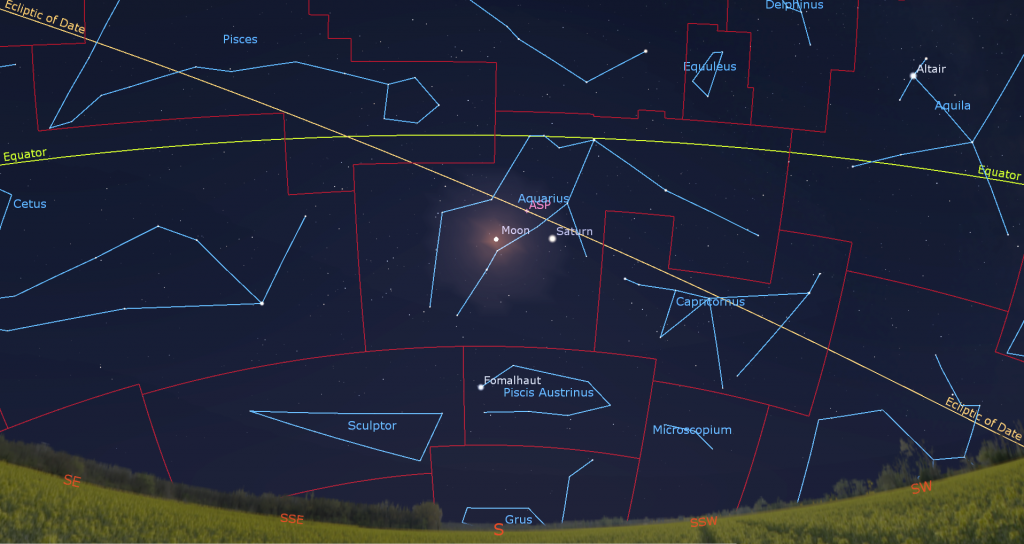
On Thursday, August 31 at 01:36 Greenwich Mean Time, which converts to Wednesday evening at 9:36 pm EDT and 6:36 pm PDT in the Americas, the moon will reach its full phase for the second time in August. When a lunar phase occurs on the first day or two of a calendar month, it will be repeated at month-end. An early-month full moon that repeats is colloquially known as a “Blue Moon”. Blue moons occur once every two or three years and do not display any unusual coloration. The moon will also be full only 9.5 hours after its perigee, making this the largest full moon in 2023, and a supermoon – appearing about 7% larger and shining a bit brighter than average. The world will experience higher tides due to this full moon’s proximity to Earth. I wrote more about supermoons last month here.
The moon will be waning from Thursday night onward. But its bright light will hide the stars of Aquarius (the Water-Bearer) around it. The moon will end the week by passing through Pisces (the Fishes), and then joining Jupiter in Aries (the Ram) next Sunday.
Medusa Closes Her Eye
The star Algol (or Beta Persei) in the constellation of Perseus (the Hero) is among the most easy-to-monitor variable stars. During a ten-hour period that repeats every 2 days, 20 hours, and 49 minutes, Algol dims by a third and then re-brightens when a companion star with an orbit nearly edge-on to Earth crosses behind the much brighter main star, reducing the total light output we perceive. Algol normally shines at magnitude 2.1, similar to the nearby star Almach in Andromeda (the Princess). But while dimmed to minimum brightness, Algol’s magnitude 3.4 is almost the same as the star Rho Persei (ρ Per), which shines just two finger widths to Algol’s lower right (or 2.25 degrees to the celestial south).

For observers in eastern North America, fully dimmed Algol will sit in the lower part of the northeastern sky on Sunday, August 27 at 11:32 pm EDT (or 03:32 GMT on August 28). Five hours later the star will shine at full intensity from a perch high in the eastern sky. Observers in more westerly time zones can see the latter stages of its brightening.
The Planets
Saturn is the showpiece for evening planet-viewing this week. Early this morning (Sunday, August 26) in the Americas, Saturn reached opposition for 2023. Planets at opposition rise at sunset and set at sunrise because Earth is positioned between them and the sun. That also minimizes our distance from them. This week, Saturn will be at a distance of 1.311 billion km, or 73 light-minutes from Earth. It will shine at magnitude of 0.41 – its brightest for the year. In a telescope Saturn’s globe and rings will show maximum apparent diameters of 19 arc-seconds and 44 arc-seconds, respectively. Opposition is also the optimal time to view Saturn’s moons through a backyard telescope in a dark sky.
The ringed planet will clear the rooftops by about 9 pm – but you’ll get the clearest views of Saturn in a telescope between 10:30 pm and 3 am, when it’s highest. (Thankfully, those times are advancing by half an hour each week.) The faint stars of Aquarius (the Water-Bearer) will be shining around Saturn, the bright trio of the Summer Triangle asterism stars will sparkle well above, and the Great Square of Pegasus will be off to the planet’s upper left. The very bright star Fomalhaut (or Alpha Piscis Austrini, the Southern Fish) will shine two fist diameters below Saturn all year. The bright moon will hop past Saturn on Tuesday-Wednesday.
Saturn’s beautiful rings are visible in any size of telescope. If your optics are of good quality and the air is steady, try to see the Cassini Division, a narrow gap curving between the outer and inner rings, and a faint belt of dark clouds that encircle the planet’s globe. Remember to take long, lingering looks through the eyepiece – so that you can catch moments of perfect atmospheric clarity. Good binoculars can hint at Saturn’s rings, too.
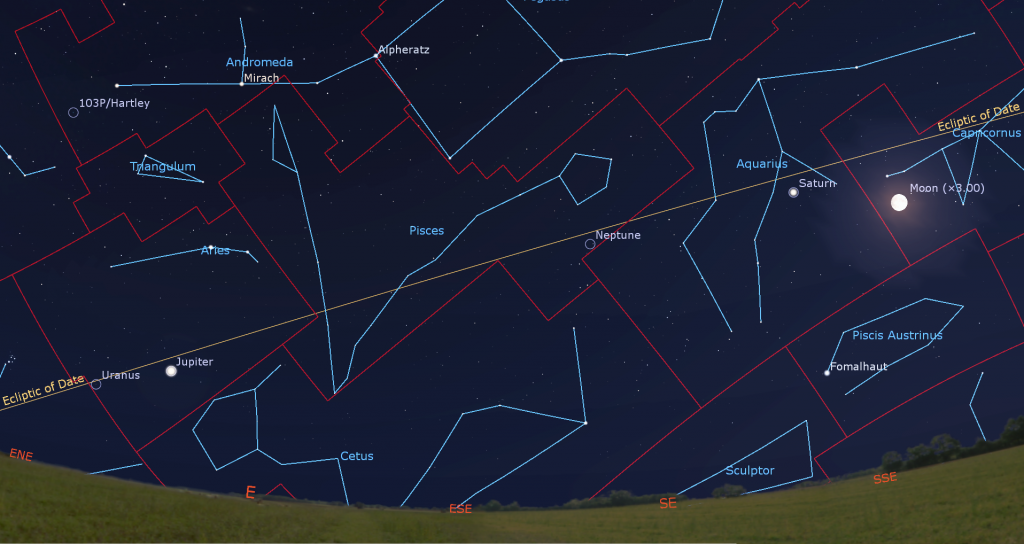
From here on Earth, Saturn’s axial tilt of 26.7° lets us see the top of its ring plane, and allows its brighter moons to array themselves above, below, and alongside the planet. Saturn’s largest and brightest moon Titan never wanders more than five times the width of Saturn’s rings from the planet. The much fainter moon named Iapetus can stray up to twelve times the ring width during its 80-day orbit of Saturn. The next brightest moons Rhea, Dione, Tethys, Enceladus, and Mimas all stay within one ring-width of Saturn.
During this week, Titan will migrate counter-clockwise around Saturn, moving from the planet’s lower left (celestial east) tonight (Sunday) to Saturn’s upper right (celestial west) next Sunday night. (Remember that your telescope will probably flip the view around.) How many of the moons can you see in your telescope? You may be surprised at how many you can see if you look closely. Saturn will be available for our evening viewing pleasure through its opposition in late August and then on until mid-winter! This summer the blue ice giant planet Neptune, currently 840 times fainter than Saturn, will be lurking about two fist diameters to Saturn’s left, or 23° to its celestial northeast.
Brilliant, white Jupiter, which currently shines about 15 times brighter than Saturn, will join the party once it rises around 10:30 pm local time. This year Hamal and Sheratan, the brightest stars of Aries (the Ram), will shine a generous fist’s diameter above the giant planet. Jupiter should catch your eye while it gleams high in the southern sky before sunrise.
Binoculars will show you Jupiter’s four Galilean moons in a line beside the planet. Named Io, Europa, Ganymede, and Callisto in order of their orbital distance from Jupiter, those moons complete orbits of the planet every 1.7, 3.6, 7.2, and 16.7 days, respectively. If you see fewer than four moons, then one or more of them is crossing in front of or behind Jupiter, or hiding in Jupiter’s dark shadow – or two of the moons are very close together or occulting one another. All four of them will huddle to the west of Jupiter next Sunday night.
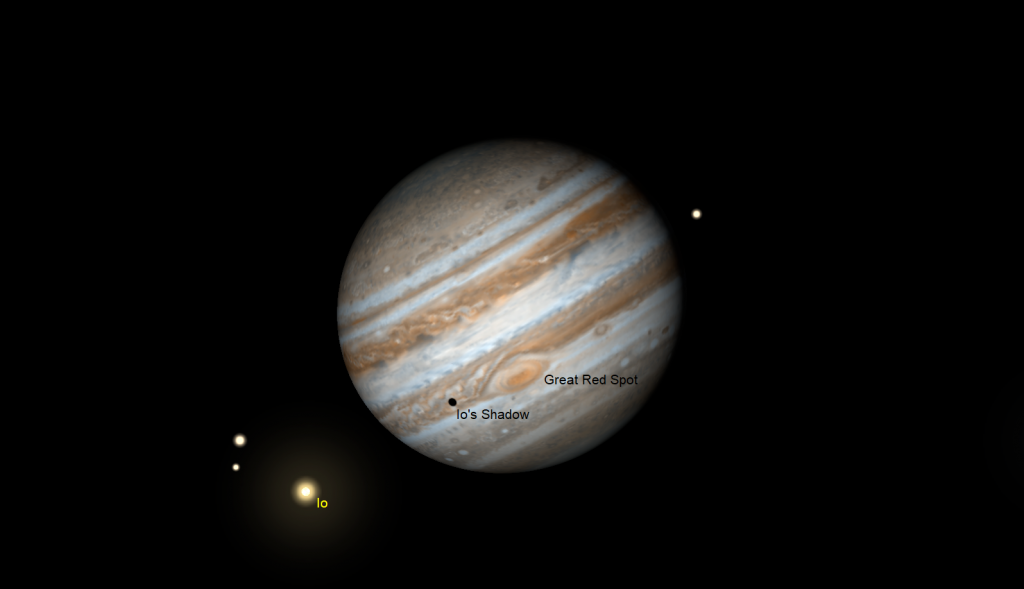
Jupiter will climb high enough for good telescope views after about 12:30 am local time. It’ll look even better from then until dawn, when it will shine high in the southwestern sky. Even a small, but decent quality telescope can show you Jupiter’s dark belts and light zones, which are aligned parallel to its equator. With a better grade of optics, Jupiter’s Great Red Spot, a cyclonic storm that has raged for hundreds of years, becomes visible for several hours when it crosses the planet every 2nd or 3rd night. For observers in the Americas, that GRS will cross Jupiter’s disk late tonight (with Io’s black shadow), Friday, and next Sunday. It’ll appear early on Wednesday and Friday morning, and before dawn on Tuesday, Friday and next Sunday morning. If you have any coloured filters or nebula filters for your telescope, try enhancing the spot with them.
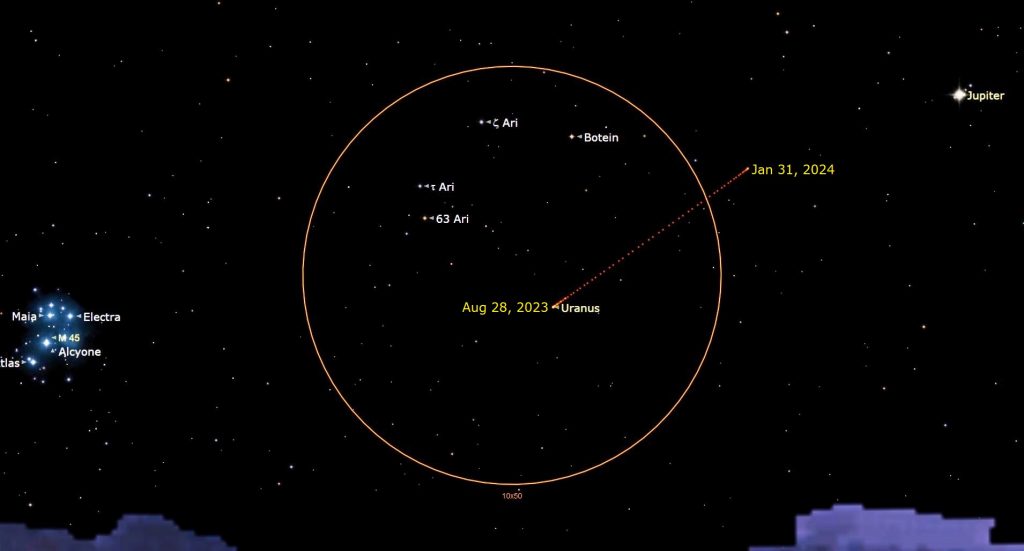
From time to time, the small, round, black shadows cast by Jupiter’s Galilean moons become visible in amateur telescopes when they cross (or transit) the planet’s disk. On Sunday night, August 27, Io’s small shadow will accompany the Great Red Spot across Jupiter’s equatorial region from 11:28 pm to 1:32 am EDT (or 03:28 to 05:32 GMT).
The blue-green ice giant planet Uranus will be following Jupiter across the sky this year. On Monday night, Uranus’ easterly motion across the stars of eastern Aries will slow to a stop as it prepares to commence a westward retrograde loop that will last until late January, 2024. Retrograde loops occur when Earth, on a faster “inside track” around the sun, overtakes the slower outer planets, making them appear to reverse course for a while. This week Uranus will be located a generous palm’s diameter to Jupiter’s lower left (or 7.5° to the celestial east). The bright little Pleiades Star Cluster will be located a similar distance to Uranus’ left. Magnitude 5.8 Uranus is visible in binoculars and small telescopes if you know where to look. I’ll get more specific in the coming weeks when it will climb higher.
Brilliant Venus will be shining in the eastern pre-dawn sky from now until January, climbing farther from the sun with each passing day. In a telescope, it will exhibit a large disk and a very slim waxing crescent phase. Turn all optics away from the eastern horizon before the sun rises.
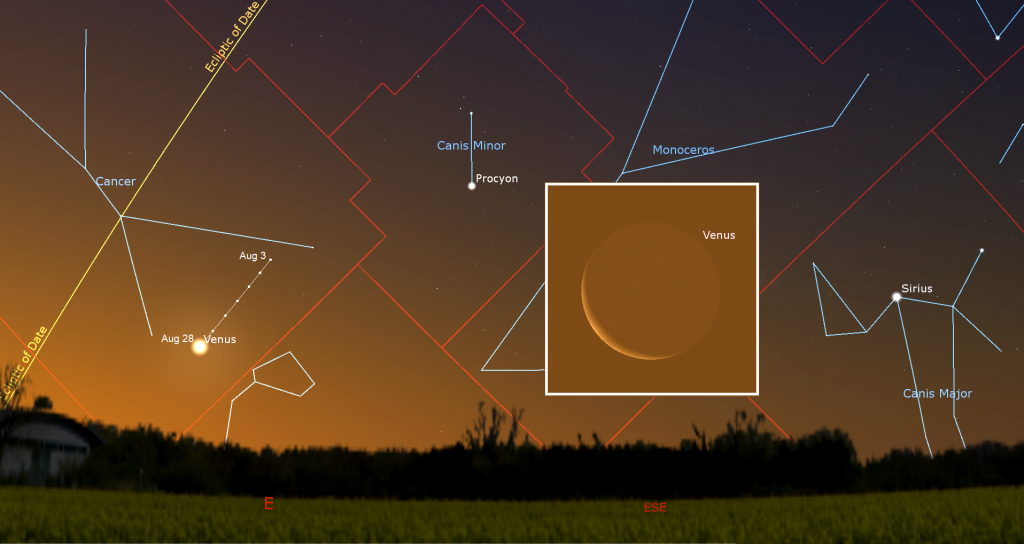
Soaring with Cygnus
If you missed last week’s tour of the great constellation Cygnus (the Swan) I posted it here.
Public Astronomy-Themed Events
Every Monday evening, York University’s Allan I. Carswell Observatory runs an online star party – broadcasting views from four telescopes/cameras, answering viewer questions, and taking requests! Details are here. They host in-person viewing on the first clear Wednesday night each month. Other Wednesdays they stream views online via the observatory YouTube channel. Details are here.
On the first clear weeknight this week (August 28 to Sep 1) the public are invited to Binoculars Stargazing on the lawn at the David Dunlap Observatory. Arrive for this free program at sunset. You’ll learn to use star charts and basic observing techniques, and then use your binoculars to follow a guided tour through the night sky by RASC Toronto Centre astronomers, and stay after the tour to practice your new skills. Please wear / bring appropriate supplies for being outside. Note that there is no building or washroom access during this program. All participants under the age of 16 must be accompanied by an adult. As this program is weather dependent, please visit RASC Toronto’s home page or Facebook page for a GO or NO-GO call.
My free, family-friendly Insider’s Guide to the Galaxy webcast with RASC National returns on Tuesday, August 29 at 3:30 pm EST. We’ll review what’s up in the sky over the next while. We’ll end the show by highlighting our final batch of RASC Finest NGC objects. You can find more details and the schedule of future sessions here.
If it’s sunny on Saturday morning, August 5 from 10 am to noon, astronomers from the RASC Toronto Centre will be setting up outside the main doors of the Ontario Science Centre for Solar Observing. Come and see the Sun in detail through special equipment designed to view it safely. This is a free event (details here), but parking and admission fees inside the Science Centre will still apply. Check the RASC Toronto Centre website or their Facebook page for the Go or No-Go notification.
Keep your eyes on the skies! I love getting questions and requests. Send me some!